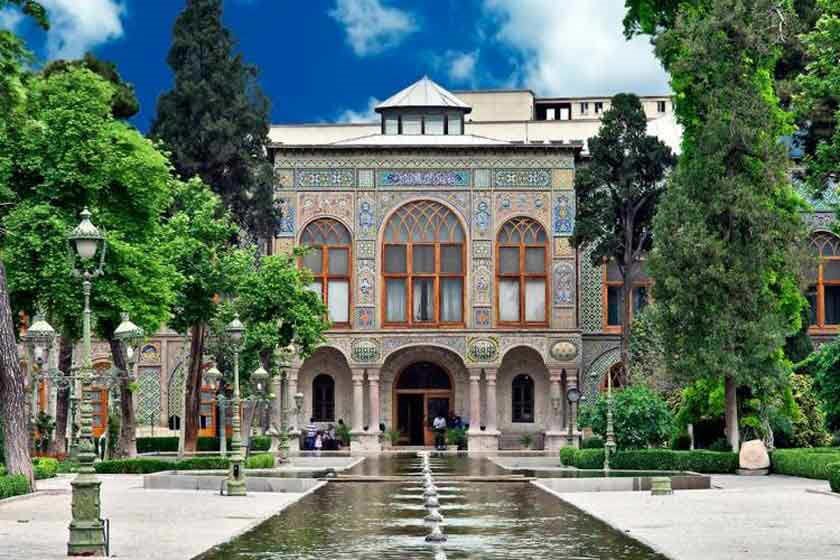Royal palaces you must see in Tehran

TEHRAN – Known for its cool climate and old plane trees, Tehran has long been a favorite of Iranian kings.
A number of historical palaces can be found in the Iranian capital, which has always been a center of decision-making, power, and politics.
Several palaces date back to the Qajar-era (1789-1925), which were later restored and renovated, but some were destroyed and rebuilt in the Pahlavi period (1925-1979).
Qajar palaces are simpler than those of the Pahlavi era, while Pahlavi palaces are more luxurious and modern.
These are some of the palaces that one should see while in Tehran.
UNESCO-tagged Golestan Palace
A destination for domestic and international travelers, Golestan Palace is located in the heart and historic core of Tehran. The palace complex is one of the oldest in the Iranian capital, originally built during the Safavid dynasty (1501–1736) in the historical walled city.
Located in the heart of Tehran, the palace is like a beautiful pearl that evokes an innate sense of the luxury of Persian kings. Beautiful fountains and lush greenery surround the palace.
Following extensions and additions, it received its most characteristic features in the 19th century, when the palace complex was selected as the royal residence and seat of power by the Qajar ruling family (1789-1925). At present, the Golestan Palace complex consists of eight key palace structures mostly used as museums and the eponymous gardens, a green shared center of the complex, surrounded by an outer wall with gates.
The palace contains numerous ornaments dating from the 19th century, which are one of its distinguishing features. Palace visitors are impressed by the palace's lavish decoration: painting, mural, fresco, marble carvings, mirror mosaic, and stained glass.
Talar-e Salam, or the reception room, is perhaps the most famous hall in the palace and is where the kings welcomed foreign guests arriving in Iran. Beautiful mirrorwork by Iranian masters decorates the ceilings and walls of this hall, and marble mosaics cover the floors.
UNESCO has it that the complex exemplifies architectural and artistic achievements of the Qajar era including the introduction of European motifs and styles into Persian arts.
Niavaran Palace
Niavaran Cultural-Historical Complex, covering an area of about eleven hectares, is composed of several landmark buildings, museums, and monuments constructed in the 19th and 20th centuries during the Pahlavi and late Qajar eras.
The history of the palace complex stretches back to about 280 years ago when Fath-Ali Shah of the Qajar Dynasty ordered for a summer residence to be built over the then countryside area of the capital. The two-story Ahmad Shahi Pavilion is one of the highlights of the complex.
The main palace of the complex was originally erected for the purpose of royal ceremonies and gatherings. However, it later turned into the resident of the second king of Pahlavi king, Mohammad Reza Shah, and his family.
With an area of 9,000 square meters, the palace is entirely adorned with magnificent plasterwork, mirrorwork, and tilework. Its architecture boasts a blend of pre- and post-Islamic art.
Its beautifully decorated and fully furnished interior features loads of artworks such as precious paintings and sculptures by Iranian and foreign artists.
Sa’dabad Palace
Sprawled on about 110 hectares of a mountainside parkland in northern Tehran, the Sa’dabad Cultural-Historical Complex is used to be a royal summer residence during the Qajar and Pahlavi eras.
The complex was initially established and inhabited by some Qajar monarchs in the 19th century. It has undergone further expansions from the 1920s until the 1979 Islamic Revolution. The site embraces a variety of buildings, some of which turned to be house museums showcasing a wide range of royal families’ memorabilia including lavishly-made furniture, dishware, automobiles, carpets, and miniature paintings.
Among the most famous and beautiful palaces of the complex are Green Palace and Ahmad Shah Palace.
The Green Palace was built by the order of Reza Shah in 1922. The palace is built of marble and decorated with stucco. The palace contains oil paintings depicting stories from epic Persian poet Ferdowsi’s Shahnameh. The aristocratic French style is represented in the halls of this palace.
Ahmad Shah Palace is the oldest palace in Sa’dabad complex and Part of this palace is now in the hand of the presidential administration.
The first time Tehran is mentioned in historical accounts is in an 11th-century chronicle in which it is described as a small village north of Ray.
Tehran has many to offer its visitors including Grand Bazaar, Treasury of National Jewels, National Museum of Iran, Glass & Ceramic Museum, Masoudieh Palace, Sarkis Cathedral, Tehran Museum of Contemporary Art, Carpet Museum of Iran, to name a few.
ABU/MG

Leave a Comment